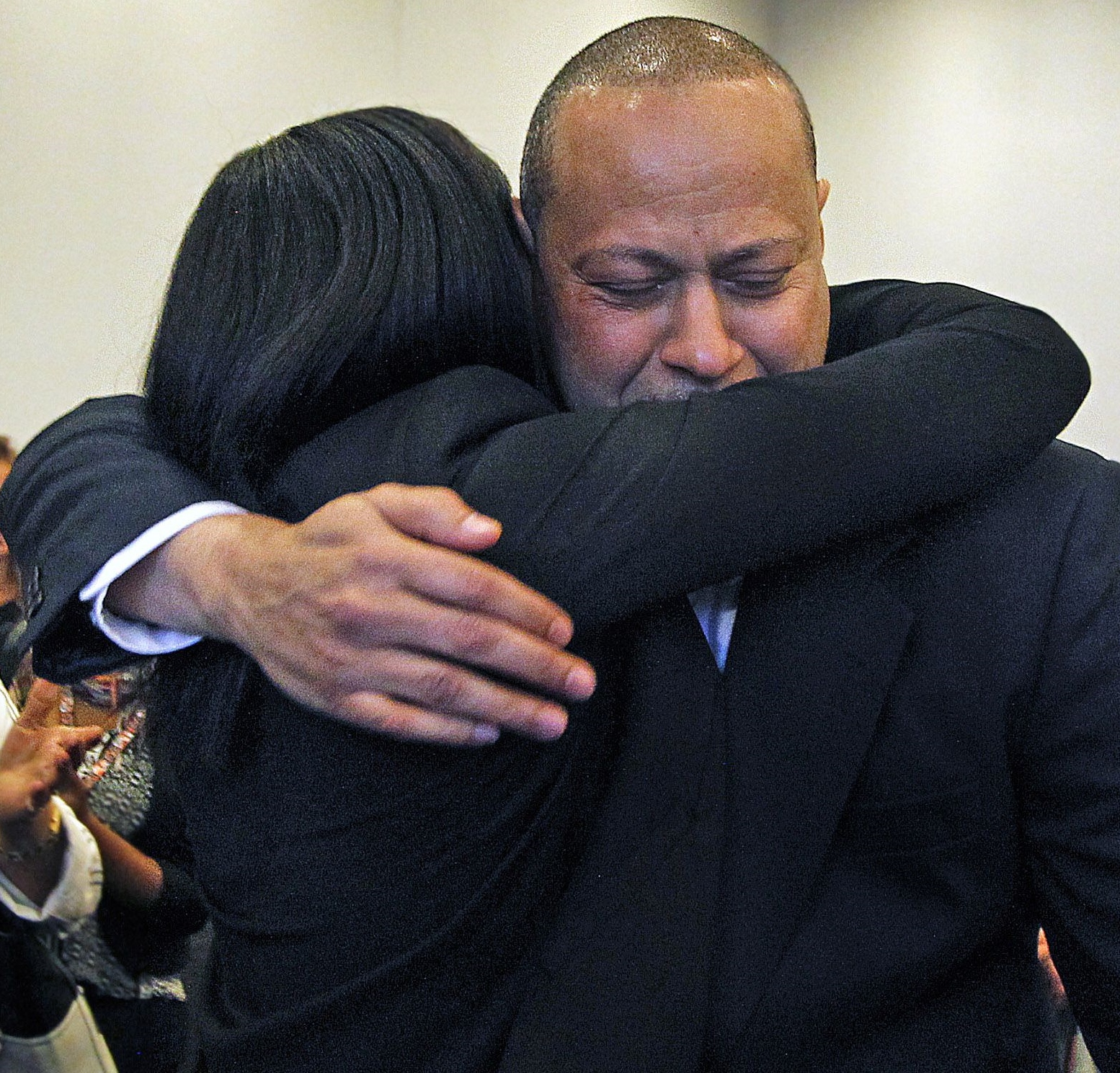 Angel Echavarria embraces his daughter upon his release. (Photo by The Boston Globe) On January 7, 1994, Isidoro Rodriguez and his 37-year-old brother, Daniel, opened the door to the apartment of their brother, Otilio, in Lynn, Massachusetts and were confronted by two armed men. The men dragged Isidoro and Daniel into the apartment. They bound Isidoro’s hands with telephone cord, forced him to the floor and put a shirt over his head.
When the gunmen had left, Isidoro untied himself and found Daniel dead in the bathroom with two bullet wounds in the head.
Isidoro described one of the gunmen as Puerto Rican (based on his speech), about 20 years old, 5 feet 10 inches to 6 feet tall with a stocky, chunky build, and clean shaven. Hours later, at the Lynn police station, Isidoro looked through six or seven books containing more than 1,200 police booking photographs of arrestees. He singled out one photograph as resembling the gunman.
The photograph was Mariano Bonafacio, who had been identified as the gunman in another shooting on November 11, 1993—less than two months earlier—and less than half a mile from where Daniel Rodriguez was murdered.
However, several days later, Isidoro saw 27-year-old Angel Echavarria in a barbershop and believed that in fact Echavarria was the gunman. Isidoro believed that Juan Rodriguez, who was with Echavarria, was the other gunman. Isidoro asked Echavarria for his name and Echavarria willingly gave it to him. Isidoro then notified police. The following day, police arrested Echavarria and Juan Rodriguez. Both said they were not involved in the shooting.
Juan Rodriguez and Echavarria, who was a native of the Dominican Republic, had a goatee and was skinny (135 pounds), were charged with first-degree murder, armed assault and armed robbery.
A year after they were arrested, police showed a photographic lineup to Gary Sevinor, who said he was also in the apartment on the night of the shooting. Sevinor was shown a photographic lineup and beneath Echavarria's picture, he wrote that he could not "swear this was the man that said, 'On the floor face down.'"
Echavarria and Juan Rodriguez went to trial in Essex County Superior Court. Isidoro identified them as the gunmen. Sevinor, who came to the apartment to buy drugs, said he gave money to someone in the apartment who left to get cocaine. When that person returned, he was being held at gunpoint by two men—one of whom he identified as Echavarria. Sevinor said Echavarria tied him up with telephone cord and forced him to lie face down on the floor. He did not see the shooting.
Echavarria’s attorney, Charles Robson, who had been retained for $2,500, told the jury in his opening statement that Echavarria would testify that he wasn’t at the apartment, had never been to the building and didn’t even know where the building was located.
However, Robson never called Echavarria to the witness stand. On January 26, 1996, the jury convicted Juan Rodriguez and Echavarria of first-degree murder, armed assault and armed robbery. However, the judge immediately vacated the jury’s verdict against Rodriguez as not supported by sufficient evidence. The judge let the verdict against Echavarria stand and sentenced him to life in prison without parole.
In 2000, Echavarria wrote to the New England Innocence Project, which, at the time, was only taking on possible wrongful conviction cases with clear DNA evidence. In 2005, the Project referred Echavarria's case to the Schuster Institute for Investigative Journalism at Brandeis University. Over the next decade, the Institute uncovered evidence showing that Echavarria’s attorney had never been informed that Bonafacio had been indentified as the suspect in the November 11, 1993 shooting in Lynn.
In 2008, DNA tests were performed on the telephone cords used to bind Isidoro and Sevinor. The profiles of two unidentified males were discovered. Echavarria’s DNA was not found on the cords.
A motion for a new trial was filed and a hearing was held over three days in December 2014 and March 2015. On April 30, 2015, Superior Court Judge David Lowy granted the motion.
In the ruling, the judge noted that the eyewitness evidence against Echavarria was questionable. Evidence showed that at the time of the shooting, Isidoro was a heavy drug user and was known as “El Loco,” the “crazy one” because of his irrational and unreliable behavior.
The judge credited the testimony of a witness for Echavarria that the gunmen spoke enough words at the time of the crime that someone familiar with the Puerto Rican accent would have been able to accurately distinguish whether their accents were Puerto Rican—a much different than a Dominican accent.
The judge found that Robson, (who, one year after Echevarria's trial, was suspended for three years for unrelated reasons), had made a “serious mistake” in promising the jury that Echavarria would testify, but failing to call him to the witness stand. The judge also said Robson had failed to adequately confront Isidoro's trial testimony that Bonifacio was not the gunman with Isidoro's testimony at the pre-trial preliminary hearing where he said he wasn't sure if Bonfacio was or was not the gunman.
Echavarria was released with an ankle monitor on May 18, 2015. On June 15, 2015, the Essex County District Attorney dismissed the charges.
Subsequently, Echavarria filed a lawsuit in Suffolk County Superior Court seeking compensation from the state of Massachusetts. The state agreed to settle the lawsuit for $450,000 in December 2016. Echavarria also filed a federal civil rights lawsuit, which was settled for $5 million in 2022.
– Maurice Possley
|